At his first meeting of city leaders since his election as 8th-term mayor
By Publisher Lee Kyung-sik with Editors Kim Hyung-dae, Lee Min-seok
Mayor Lee Jang-woo of the Daejeon Metropolitan City hosted the first expanded meeting for the leaders and key members of the City at the city hall conference room in Daejeon on July 5, 2022, and emphasized that the last stronghold for the citizens is the public officials. Then he ordered the creation of a culture of public service where all the members work well.
According to information provided to The Korea Post media by Public Relations Managers and Personnel Park Do-hyun, Yoo Sang-hui and Lee Jae-hyung at the Daejeon City Government, Mayor Lee said: "All public officials are the last bulwark to protect the lives and properties of the citizens. We should be one in our effort to solve all the problems that face our city today.”

“There is nothing that public officials cannot do to create a positive boom in the city and in this effort I would try to become one together with all the citizens of the Daejeon City,” Mayor Lee emphasized.
Mayor Lee then presented his opinion on each recommendation and report as an 8th-term elected mayor of the city, and requested active participation by all public officials in the proper implementation of all the tasks of the city .
First, regarding the area of revitalization of the local economy, Mayor Lee explained the industrial development plan that maximized the advantages of the Science City such as strengthening practical cooperation with the Daedeok Special District and fostering the defense industry and bio-health areas.
Regarding the collaboration with Daedeok Special District, Mayor Lee said, “The city should become a complete team with the Daedeok Special District and KAIST.”
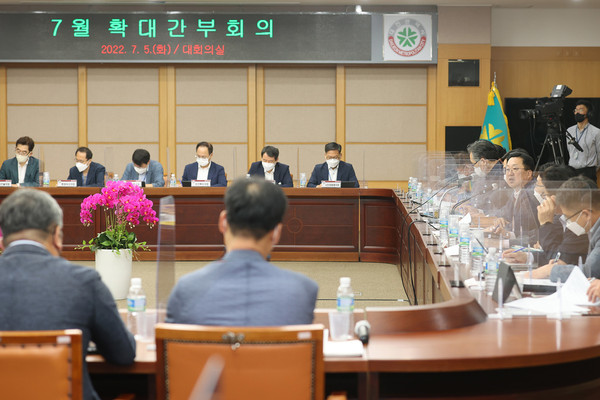
“Based on this, we can expect to revitalize the local economy by carrying out big projects for city development and nurturing businesses,” he said.
Regarding the development of the defense industry, Mayor Lee said: “Compared with the large-scale defense equipment production industry in the Changwon area, our city should become a center of defense industry such as advanced technology, sensors, and robots suitable for the 4th Industrial Revolution.”
In addition, Mayor Lee said, “Even though our city has accumulated the best R&D technology in the field of bio-health, related government projects were lost to Incheon and there were difficulties.”
“However, by taking advantage of the Science City, we will independently promote the Daejeon-style bio-health industry without relying on the central government but actively nurture related companies.”
In addition, in relation to the the field of nanotechnology, Mayor Lee said: “Based on the technology accumulated by the Institute of Nanotechnology in Daedeok Innopolis, we will try to substantially increase the number of related research personnel and secure professional industrial guidance to make Daejeon the center of related industries.”
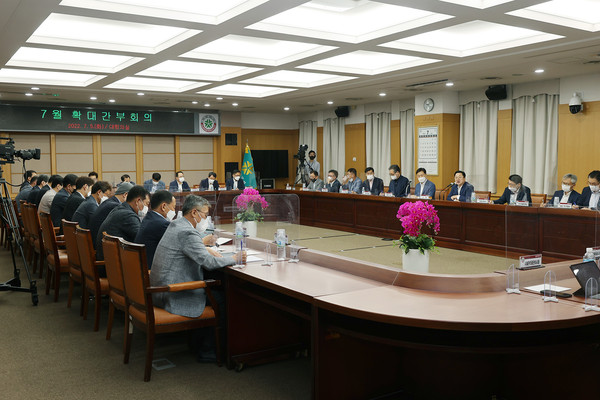
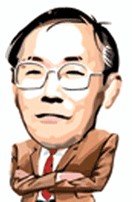
In particular, Mayor Lee asked all the public officials to take an active role in protecting and nurturing local businesses.
Mayor Lee said: “When business companies from other regions, especially the construction companies, enter our city, they also bring their business partners, posing difficulties for local businesses in our region.”
He emphasized, “All the city government officials must try to show that it is not easy for them to work in Daejeon if companies from other regions do not cooperate with the local businesses in our region.”
Regarding the establishment of a regional bank related to this, he instructed, “For the establishment of a regional bank that is closely related to the local economy, maximum extent of efforts should be made to organize a promotion committee that would include experts from the business community and the financial sector and do their best so that it can be established without delay.”
In the area of livelihood and communication among the citzens, Mayor Lee urged direct communication with citizens and the preparation of practical support measures for infants and children.
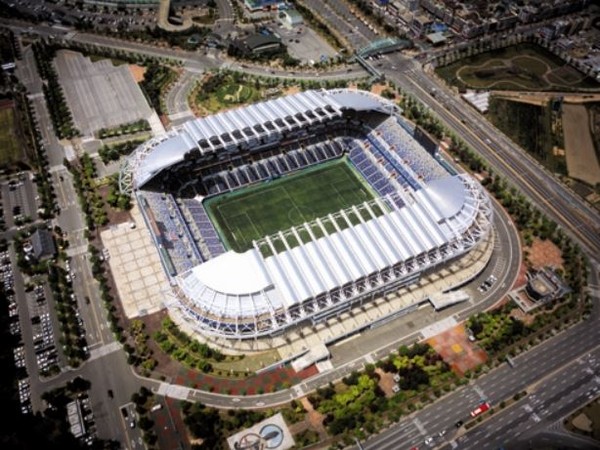
Regarding communication with citizens, Mayor Lee said, "It is necessary to collect the opinions of civic groups, but it is not desirable that the opinions of civic groups are distorted or transmitted by intermediate groups. We will actively promote direct communication with citizens and put the interests of citizens first.”
In addition, regarding welfare policies such as housing for the youth and childcare, Mayor Lee said, “We will implement a policy to provide support in housing expenses to alleviate the monthly rent burden on the young people living in Daejeon.” Then he said, “At the same time, we should try to consult with the city education office to provide free education for children aged between 3 and 5."
In the transportation sector, Mayor Lee suggested that undergrounding of the Yuseong IC section of the Honam Expressway, solving the problem of the urban railway Line 2 construction plan, preparing precise measures for the congestion in the city center, and expanding the river-bank road.
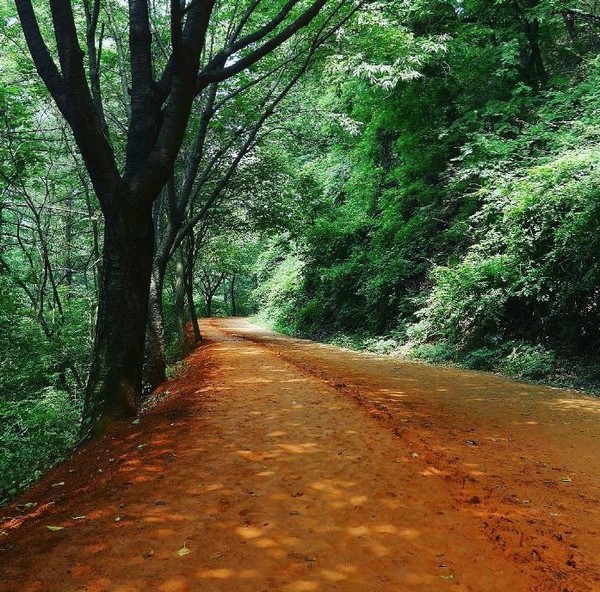
Regarding the undergroundization of Honam Expressway, Mayor Lee said, “The current Yuseong IC has a lot of traffic, but congestion occurs due to structural problems such as the signal system. It is desirable to make the 7-killometer section underground and to open four entrances and exits to disperse it.”
In addition, Mayor Lee added, “The land created by the expansion of underground ways can be used as a park, youth housing, and industrial land.”
Mayor Lee also emphasized, “The personnel at the tram construction headquarters should try to do their best to comprehensively review the issues that have cropped up and try to find multiple alternatives so that policy decisions can be completed by the end of this year.” Then he added: “The related budget matters will be actively handled by myself, the deputy mayor, and the budget department officials to seek central government cooperation.”
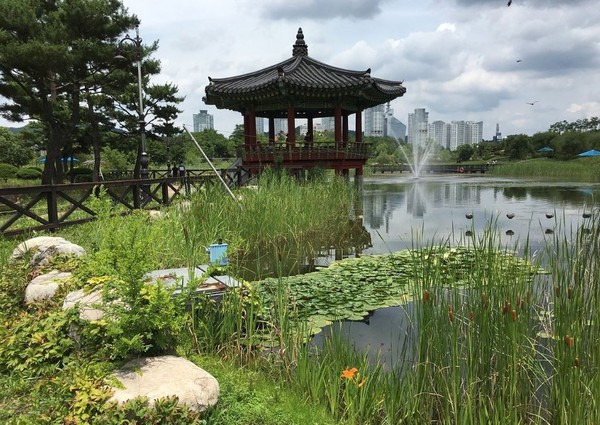
Regarding the road section of habitual congestion in the city, Mayor Lee said, “Try to identify the congestion section by time on a single map and establish a comprehensive countermeasure.”
Regarding the current riverbed road, Mayor Lee said, “In the long term, we will dispose of the riverbed road, restore it as a nature-friendly space, and expand the streamside river-bank road instead. We will try to make sure that there is no inconvenience to the citizens by securing alternative means in advance and removing them.”
Regarding the cultural tourism and residential environment sector, Mayor Lee expressed his opinion on the abolition of unnecessary festivals, a complete survey of modern buildings, and the development of tourism on the Bomun-san Mountain.
Mayor Lee said, “We will restructure festivals not related to our city, such as wine festivals, and hold all city festivals in the direction of revitalizing the civil economy. A good example would be the ‘Zero O’clock Festival,’ where several autonomous districts can work together and local small business owners can enjoy economic benefits.”
In addition, Mayor Lee added, “We will try to improve the elements of local culture and tourism by securing historicity through complete investigation of modern buildings, revitalizing tourism around Mt. Bomun, and promoting cluster core city.”
Regarding housing development, Mayor Lee said: “The basis of housing policy is to solve the problem within the currently developed city. Let’s solve the problem by adjusting the floor area ratio and licensing issues on the current land instead of external expansion, and use the remaining land for the future such as industry and job creation.
He also made it clear that the highest priority in organizational management would be to create a public office culture that does a good job.
Mayor Lee said, “We will create an atmosphere and culture where people who work hard are duly treated, excluding personal relationship, localism, academic relationship and personal feelings. I will try to actively take steps to turn your creative ideas into good results.”
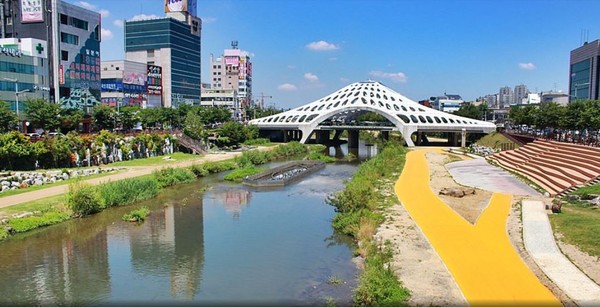
In addition, at the meeting, Mayor Lee presented his opinions on securing water for Daejeon Stream using Daejeon Lake, utilizing smart farms in the vacant space in the original city center, eradicating excessive fees for intermediary agencies through joint purchase of eco-friendly agricultural and fishery products, and strengthening countermeasures against radioactive waste.
In his closing remarks, Mayor Lee said: “All the city officials should work together to protect the properties and lives of the citizens, protect the socially disadvantaged, improve social welfare, and increase the city’s competitiveness by ensuring that the budget is not used in the wrong places. I will do my best to make you enjoy doying your work!”
Editor's note:
Mayor Lee Jang-woo is from the ruling People Power Party of the incumbent President Yoon Suk-yeol. Mayor Lee obviously stands a very good chance to honor all his commitments and promises in view of the fact that in many areas his ambitions and plans come pat to those of President Yoon.
In the opinion of many people in Korea, espeically those in Seoul and other major cities across the country, President Yoon is given favorable reviews and this relfects very well upon Mayor Lee in his effort and amibition to carry into reality all his ambitious plans for the promotion and enhancement of benefits and happiness of his people.
Mayor Lee leads the Daejeon City with 539.85 km2 (208.44 sq mi) in land size with a population totaling 1,469,543 persons (as of January 2022).
The Daejeon City symbols are: White magnolia (city flower), pine tree, and magpie (city bird).
The city's GDP is US$39.6 billion and GDP per capitaus US$25,976.
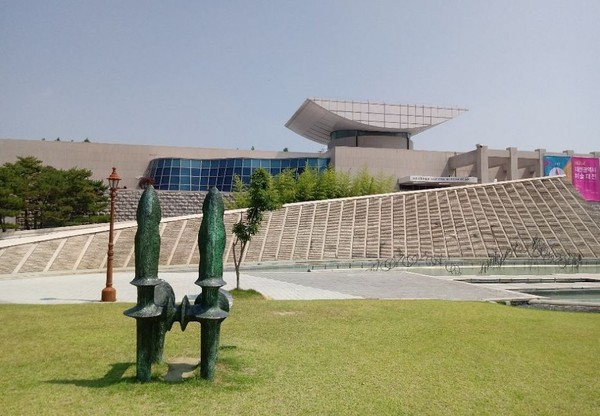
Daejeon is the fifth-largest metropolis of the Republic of Korea located in the central region of the country alongside forested hills and the Geumgang River. Daejeon is known both for its technology and research institutions, and for celebrating its natural environment, with many mountains, hot springs, and rivers freely open for public use.
Daejeon serves as a hub of transportation for major rail and road routes in Korea, and is approximately 50 minutes from the capital, Seoul, by KTX or SRT high speed rail.
Daejeon is one of Korea's administration hubs with the Daejeon Government Complex (Other administrative hubs: Seoul, Gwacheon and Sejong City).
The Korean administration in the 1980s decided to relocate some of its functions from Seoul, the national capital, to other cities. Currently, 12 national government offices, including Korea Customs Service, Small and Medium Business Administration, Public Procurement Service, National Statistical Office, Military Manpower Administration, Korea Forest Service, Cultural Heritage Administration, and Korean Intellectual Property Office, as well as Patent Court of Korea, are located in Daejeon.
Korail, Korea Water Resources Corporation, and Korea Minting and Security Printing Corporation are also headquartered in the city.
Daejeon is home to 23 universities and colleges, including KAIST and Chungnam National University.
Daejeon has earned its name as "Asia's Silicon Valley" and "high technology city."
The city hosted the Taejon Expo '93 and the International Mathematical Olympiads in 2000. Several important research institutes are based in the city.
Daedeok Innopolis (Daedeok Research and Development Special Zone) is composed of 28 government-funded research institutions, as well as 79 private research institutes with as many as 20,000 researchers.
In addition, Daejeon established the World Technopolis Association (WTA) in 1998 with the view of realizing regional development through international cooperation with world science cities.
The WTA has grown to have 67 members from 32 countries, and it actively cooperates with many international organizations including UNESCO as its official consultative body.

History:
Human beings first settled in the Daejeon region during the Stone Age. It was occupied and in use as strategic military ground in various times by people such as the Usul-gun of Baekje, Bipung-gun of Silla, and the Hoideok-hyeon, Yuseong-hyeon, Deokjin-hyeon, and Jinjam-hyeon.
During the Joseon Kingdom Period, it remained occupied by the Hoideok-hyeon and Jinjam-hyeon of Gongju Mokha. In 1895, most of the area was made part of Hoideok-gun and Jinjam-gun, excluding some parts that belonged to Gongju-gun.
The Daejeon area was historically known as Hanbat, a native Korean term for "large field," during the Joseon Dynasty.
Known historically as 'big field,' Daejeon City lies inside a great circle surrounded by several mountains, with Gyeryong-san National Park straddling the city border on the west, and the foot of the Sobaek-san Mountain range just beyond the city to the south and east.
Three rivers run through the center of the city: Gap-cheon, Yudeung-cheon, and Daejeon-cheon. These flow roughly from south to north, eventually joining the Geum River which borders the city on the northeast. The river changes direction after leaving Daejeon, turning to the southwest and eventually emptying into the Yellow Sea near Gunsan.
According to the census of 2005, of the people of Daejeon, 21.8% follow Buddhism and 31.2% follow Christianity (20.5% Protestantism and 10.7% Catholicism). About 47% of the population is mostly not religious or follows Muslim and other indigenous religions.
There are 23 universities and colleges in Daejeon, concurrently enrolling around 90,000 students and employing 4,000 professors.

Major public universities in Daejeon include:
Chungnam National University, a major national university established for the South Chungcheong Province.
Daejeon Chungnam University, a campus in the four-year Korea National Open University system.
Hanbat National University, founded in 1927, specializing in partnerships between industry and academia.
Korea Advanced Institute of Science and Technology (KAIST), the nation's first public research-oriented science and engineering institution. The university was ranked as the best Asian science and technology school by Asiaweek in 2000.
Chungnam University Law School Building
Major private universities in Daejeon include Mokwon University, Pai Chai University (founded in 1885, one of the oldest private universities in South Korea).
Woosong University, specialized curriculum based on international exchange, foreign-language, and IT education.
Hannam University, founded in 1956 by Christian missionaries, with a main campus in O-Jeong Dong (site of the historic Missionary Village), and a branch campus is in Techno Valley.
Specialized high schools and academies include:
Daejeon Foreign Language High School is a selective high school focusing on teaching of foreign language. The school provides language education of 7 majors including English, German, French, Spanish, Chinese, Japanese, and Russian.
Daejeon Science High School is a selective high school focused on teaching science.
Taejon Christian International School is an international school in the city.
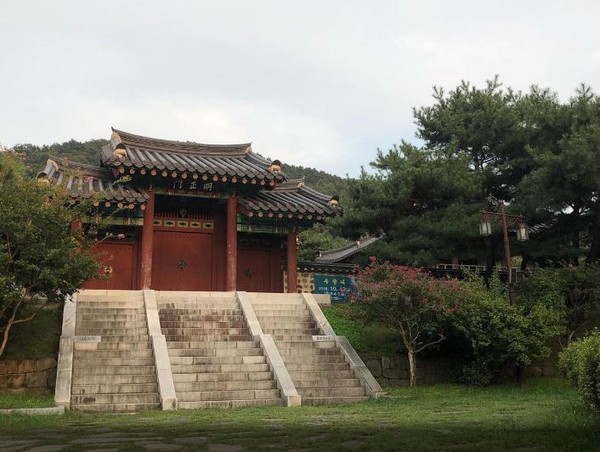
Research and development:
KAIST Campus. Known as the Silicon Valley of Korea, Daejeon is the home of private and public research institutes, centers and science parks. The R&D centers of Samsung, Institute of Information Technology Advancement, LG, Korea University of Science and Technology, Electronics and Telecommunications Research Institute and others are in Daedeok Science Town in Yuseong-gu.
Daejeon features a technology cluster known as Daedeok Innopolis defined by the national universities, Korea Advanced Institute of Science and Technology (KAIST) and Chungnam National University and surrounded by government research institutes, government-invested corporate research institutes, corporate research centers, and venture companies.
The research institutes and universities in Daedeok Valley have spun off multiple startups. Korea has invested heavily in building up the research expertise for over 30 years, creating long-term research programs. Over 7,000 PhD researchers are in the sciences in Daedeok and it had the most application for patents during 2000–2011 among the National Industrial Complex.
Researchers and businessmen work in the fields of telecommunications, nanofabrication, biotechnology, water, nuclear and hydro power, nuclear fusion, design, measurement technologies, mechanical engineering, fuel cells, aeronautics, new materials, robotics, new drugs, and environmental technologies. Daedeok Innopolis' membership includes 898 corporations, 35 government-invested and sponsored institutions; six universities, and 15 public organizations.
Among Daedeok Innopolis' universities, KAIST is considered the top technical university in Korea. Strong fields at KAIST include computer science, electrical and nuclear engineering, mechanical design, chemistry, and telecommunications. Chungnam National University also plays a central role in those fields, and brings expertise in biotechnology, medicine, and the agricultural sciences. These universities are complemented by institutions such as Hanbat National University, Pai Chai University, Hannam University, Mokwon University, and Woosong University.

Daedeok is also home to 21 corporate research centers with global reach surrounded by an equal number of smaller firms. Some of the notable corporate research centers are Dongbu Advanced Research Institute (biotechnology, microorganisms and agrichemicals), GS-Caltex Value Creation Center (environmentally friendly products including substitutes for oil), Hanwha Chemical Research (biotechnology, electronics materials, catalysts, and nanotechnology), Honam Petrochemical Daeduk Research Institute (synthetic chemistry and petrochemicals), LG Chemical LTD. Research Park (lithium ion battery and polymer battery development), Samyang R&D Center (medical research and electronics), and SK Institute of Technology (petroleum-related research).
Public corporation research institutes such as Korea Electric Power Research Institute (hydroelectric projects and nuclear energy), Korea Institute of Construction Materials (authorized test agency for construction materials), and Korea Institute of Aerospace Technology (aerospace design, satellites, launch technologies) are also part of the Daedeok system.
On 16 May 2013, Daejeon was selected as the core of the International Science and Business Belt.
Besides a tire production facility, Hankook Tire has its main R&D centre in Daejeon.
Arts and culture, museums:
Daejeon Arts Center: With two performance halls and exhibition venues, the center is home to multiple local music and theater groups including the Daejeon Philharmonic Orchestra, which recently completed several international tours, including visits to the United States and Japan.
Daejeon Artist House: Six-floors dedicated to visual and performing arts, built on the site of the former Civic Center.
Daejeon Citizen’s Observatory: The first citizen observatory in Korea houses a 10-inch refracting telescope, the largest aperture in the country. There are also 13 telescopes in an auxiliary observation room. The observatory free of charge.
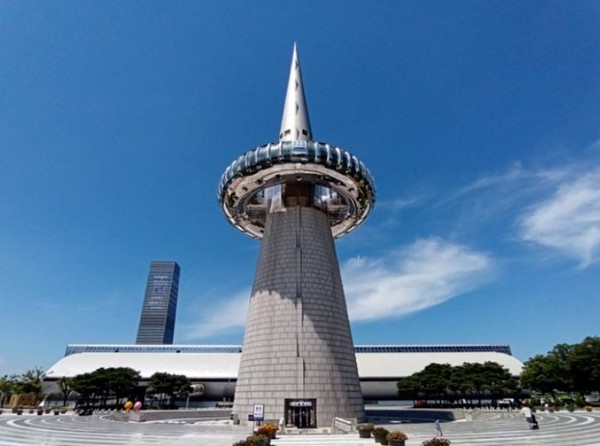
Daejeon Hanbat Arboretum, East Garden in 2021.
Daejeon Museum of Art: Modern and contemporary exhibitions featuring both domestic and foreign artists. The museum's curatorial focus is on the convergence of art and technology.
Expo Science Park: In 1993 an international exposition (Taejŏn Expo '93) was held at Daejeon. Several landmarks, such as the Hanbit Tower and the Expo Bridge, designed by Hui Lee Shun, were built at this time.
After the exposition ended, the grounds were refurbished as Expo Science Park, and parking lots were transformed into Daejeon Hanbat Arboretum. While the tower and some buildings remain, most of the expo buildings have now been removed, and a large part of the site now hosts the Institute for Basic Science.
Geological Museum: Specializing in geological specimens belonging to the Korea Institute of Geoscience and Mineral Resources in Daejeon.
Lee Ungno Museum: A large permanent collection of works by prominent Korean artist Lee Ungno (1904-1989), along with regular schedule of exhibitions featuring contemporary artists. The museum opened in 2007, and is designed by French architect Laurent Beaudouin.
National Science Museum: Korea's flagship science museum. The extensive museum campus features a main exhibition hall highlighting harmony between nature, man, and technology, as well as dedicated buildings related to natural history, future technology, biosphere, a children's science museum, and an astronomical observatory. The museum moved from Seoul to Daejeon in 1990, and is located adjacent to the Expo ground.
Natural Ecology Center at Daecheong Lake: Ecological experience learning center with resources and exhibitions on the ecology of Daecheong Lake.
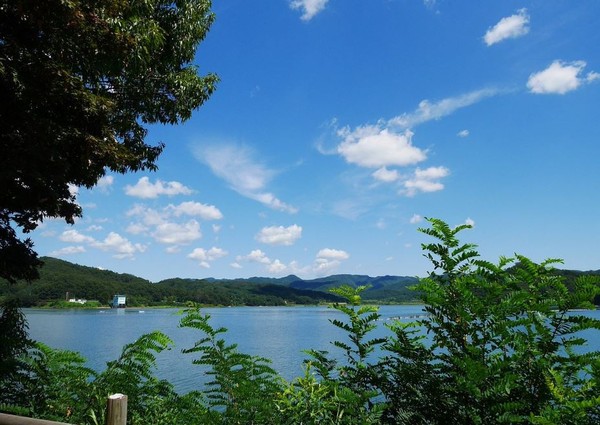
Parks and nature:
Daejeon citizens are recognized for their fondness of nature, with most mountains, hot springs, and rivers freely open for public use. Many of the city's modern-day traditions, festivals, attractions, and industries are linked in some way to important mountains, rivers, and forests.
There are eight popular places for sightseers which are designated by city government. Those eight sights include the mountains Sikjangsan, Bomunsan, Gubong-san, Jangtae-san, and Gyejok-san, the lake Daecheong Hosu, as well as Yuseong Foot Spa and Expo Science Park.
Festivals:
Daejeon Science Festival, which symbolizes the science city of Daejeon, is a representative festival. The Hyo Culture Root Festival, Daejeon International Wine Fair, Yuseong Oncheon Festival, Geumgang Rojas Festival, Diku Festival, Gyejoksan Mountain Manbal Festival and Gyeonu-wa-Jingnyeo (A Cattle Boy and a Weaving Woman) Festival will be held.

